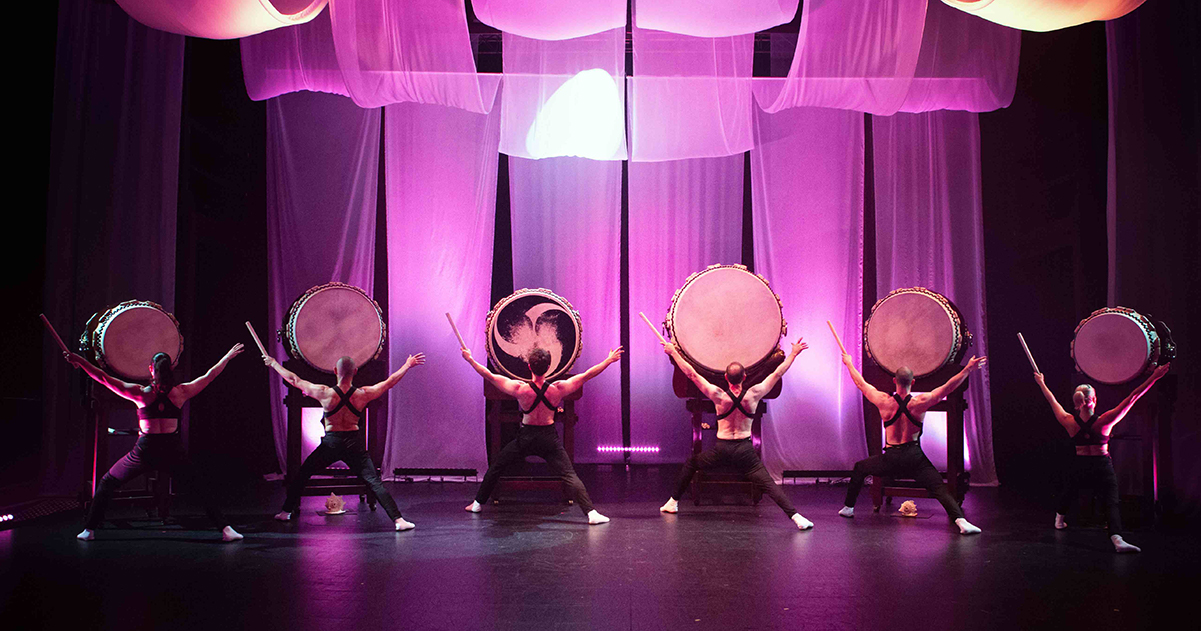About this eResource
The Beauty Of 8 eResource gives insight into a fusion of Australian and Japanese cultures and rhythm. The end product is an exciting and dynamic artform that appeals to all ages. “Taikoz is at once meditative and free-spirited, primal and dramatic.” This eResource encourages students and teachers to observe, listen, perform and compose using ancient aural traditions alongside more modern scores.
Traditionally, taiko is for males to perform. Throughout The Beauty Of 8 you will see how taiko has evolved into a new, elegant, choreographed artform for both men and women, at the hands of Chieko Kojima and Taikoz.
As well as extensive concert footage, there are many attachments in this eResource that allow students to delve further into topics such as: taiko instruments, instrument makers, Taikoz artists, tech specs (lighting and staging), dance, traditional roles of Japanese music, artistic collaborations, musical inspiration and general background.
In this eResource
In this eResource you will find many and varied activities spanning stages 4, 5 and 6. By using this eResource, teachers will present a range of Japanese-inspired drumming music with varied origins and conventions while encouraging participation in rhythmic games and performances.
Students will be given opportunities to:
- observe, discuss, experience, compare and play percussion music inspired by different regions of Japan across many centuries
- become familiar with a variety of Japanese taiko drums and other traditional instruments
- learn about the artform of taiko and its evolution in Australia
- learn about the role of percussion music in various aspects of Japanese culture and history
- observe the fusion of dance, choreography and drum performance
- experiment with aural methods of learning and sharing rhythms
- reflect on music that unites Japanese and Australian culture.
One suggested scope and sequence of this eResource is to work through the pieces in the following order, from simplest activities to the most rhythmically complex:
- Hana Hachijo
- Become
- Morf
- Pearl
The background information supplied in this eResource, particularly in the attachments, provide a wealth of knowledge about Japanese culture. When teachers read this material and relate portions to students as relevant to the learning activities, teachers are complying with teaching standard 2.1.2 (apply knowledge of the content and teaching strategies of the teaching area to develop engaging teaching activities).
Some rhythms are taught using notation. Others are taught aurally by copying an MP3. This appeals to a variety of learners, addressing teaching standard 1.3.2 (design and implement teaching strategies that are responsive to the learning strengths and needs of students from diverse linguistic, cultural, religious and socio-economic backgrounds) and 1.5.2 (develop teaching activities that incorporate differentiated strategies to meet the specific learning needs of students across the full range of abilities).
By writing the suggested learning intentions listed in this kit and referring to them throughout each lesson, teachers are addressing teaching standard 3.1.2 (set explicit, challenging and achievable learning goals for all students). The improvisation activities promote problem-solving and creative thinking as referenced in teaching standard 3.2.2 (select and use relevant teaching strategies to develop knowledge, skills, problem-solving, and critical and creative thinking).
Syllabus outcomes
If used in its entirety, teachers will cover aspects of listening, composition and performance from stages 4, 5 and 6 of the NSW Music syllabus.
- Stage 4: 4.1 4.2 4.4 4.7 4.8 4.9 4.11 4.12
- Stage 5: 5.1 5.2 5.4 5.7 5.8 5.9 5.11 5.12
- Stage 6 Music 1: P2 H2 P3 H3 P4 P5 P6 P10 H10
- Stage 6 Music 2: P2 H2 P3 P4 H4 P5 H5 P7 P11 H11
Contents of this eResource assist with the Preliminary and HSC Music topics of:
- Music and the related arts (dance)
- Music for small ensembles (taiko)
- Music of a culture (Japan)
free




